-
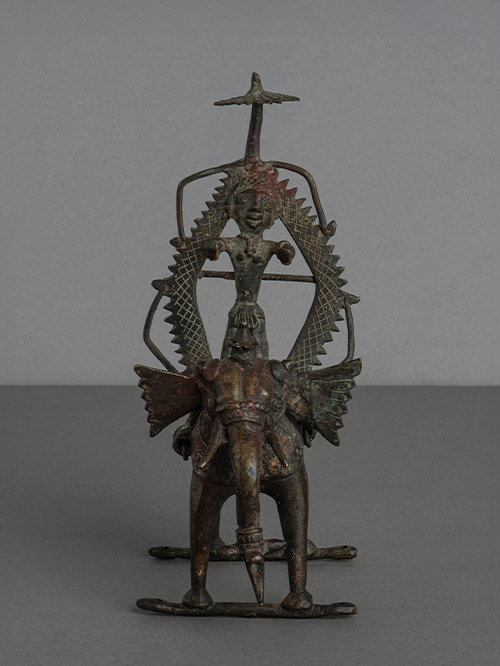
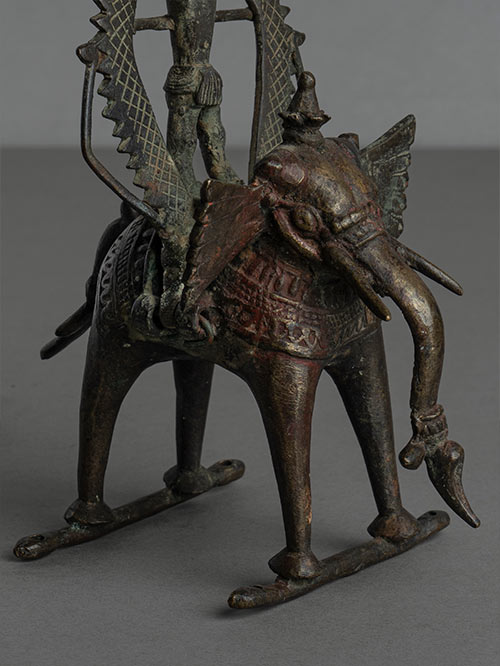
Orissa
brass alloy
A finely crafted figure of an elephant with its mahout. The caparisoned elephant is adorned with head and neck ornaments and a decorated saddle cloth, and it has a lovely curled trunk. Atop the elephant stands the Goddess Danteshwari, enclosed in a howdah shaped like a prabhavali, forming a ritual arch around the deity.
The elephant was the vahana or vehicle of god Indra. Later it became associated with deities such as Lakshmi and Danteshwari (Durga). In art and literature it became a symbol of power and might and was associated with royalty and deities. Danteshwari Mata who is a form of the powerful Goddess Durga and is also the family goddess of the princes of Bastar. The last ruler of Bastar who died in 1966 was considered her incarnation. The goddess was brought to Bastar in the 15th century by Annamdeo, an ancestor of the princely dynasty. On the run from the advancing Muslims, he had sought refuge in the impassable mountainous region of Bastar. Legend has it that the goddess appeared to him in through his royal sword and showed him the way. The sword represents the power of the victorious goddess and bestows military prowess upon its owner.
Size (cms): 19(H) x 12(W) x 8.5(D)
Size (inches): 7.5(H) x 4.5(W) x 3.5(D)
-
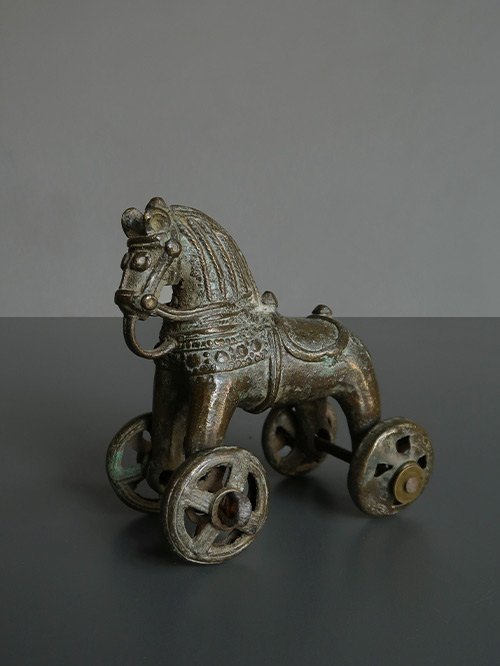
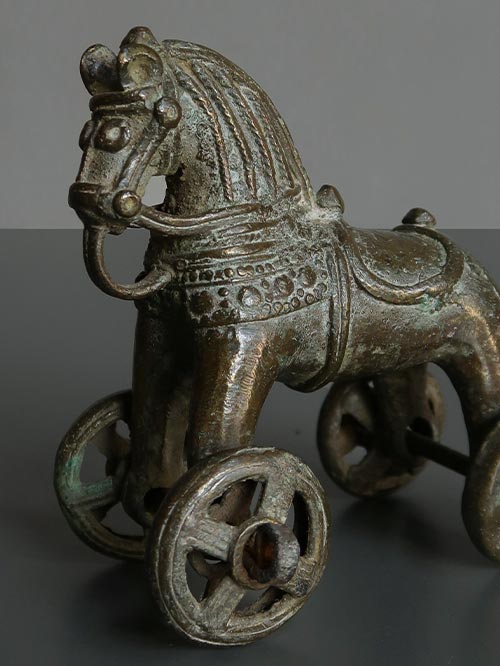
Central India
brass alloy
A lovely diminutive figure of a horse on wheels adorned with trappings and a decorated saddle cloth secured by ropes. Temple toys were used as ritual display in temples during important festivals such as Holi, Shivaratri and Durga Puja.
The horse played a pivotal role in establishing the supremacy of kings, as demonstrated, for instance by the great horse sacrifice, the Ashvamedha, which might have been established in the course of the Vedic period. Equestrian motifs appear prominently in Indian art, for example in Orissan sculpture of the 12th and 13th centuries, and in that of the late Vijaynagara and Nayak periods (early 16th to early 18th century) in southern India. There is a branch of literature specialising in the training of horses, which contains detailed passages on colouring, proportions, gait, auspicious and inauspicious marks and lists of appropriate names for horses.
Size (cms): 16.5(H) x 15.25(W) x 11(D)
Size (inches):6.5(H) x 6(W) x 4.5(D)
-

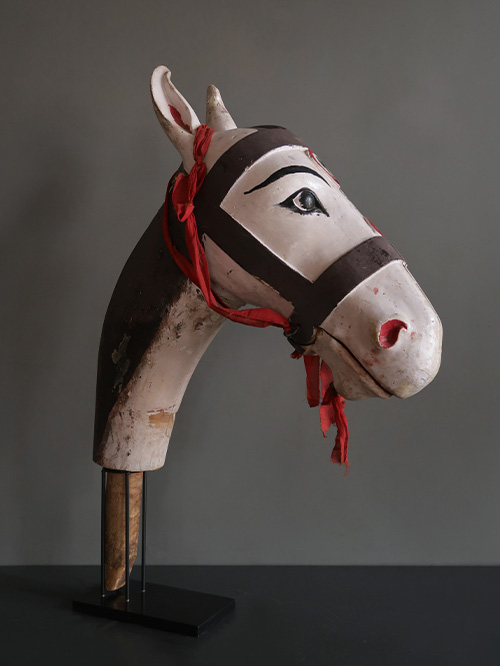
Konkan Region (Western India)
wood, polychromed
A painted wooden horse dancing mask with an articulated jaw. The head is worn through use but still shows its typical trappings.
This is a tribal dancing masks from the Konkan region used in the Perni Zagor, a folk play danced by Christian Gaud tribals. Perni Zagor is an indigenous dance-drama form of the Perni community of Goa. This is an ancient art form and is believed to have evolved on the banks of the Zuari river. It has its origins in fertility rites related to Neolithic shamanism. The dancers don wooden masks while performing the musical drama. The masks represent deities, animals, birds and demons. The characters are derived from various episodes in Hindu mythology. Perni Zagor is currently performed by only a few families in the community and is almost on the verge of extinction.
Size (cms): 86.5(H) x 57(W) x 17(D)
Size (inches): 34(H) x 22.5(W) x 6.5(D)
-
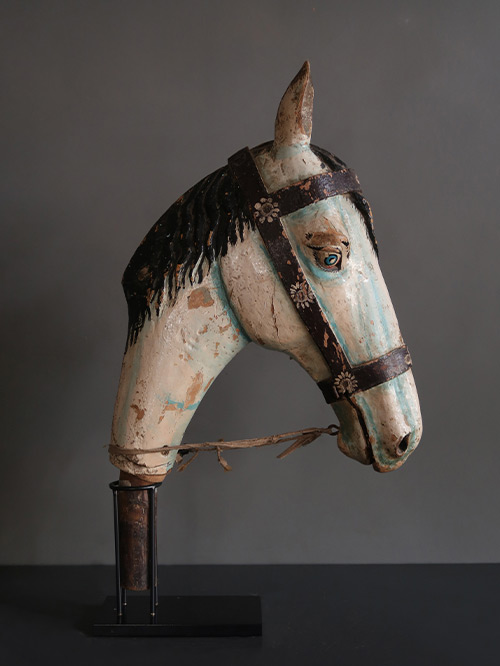
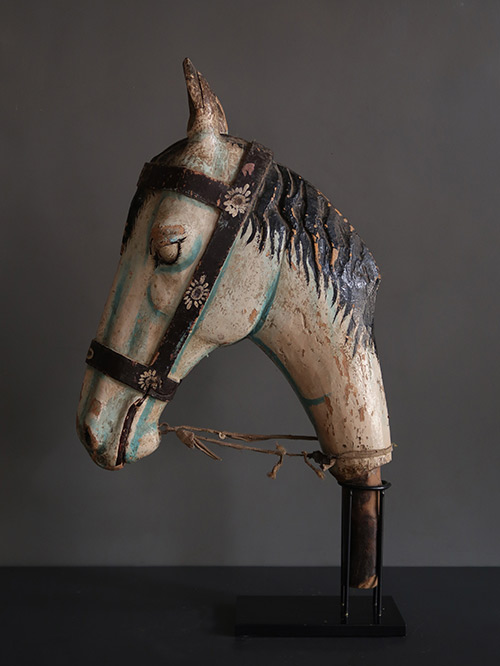
Konkan Region (Western India)
wood, polychromed
A painted wooden horse dancing mask with an articulated jaw. The head is worn through use but still shows its typical trappings.
This is a tribal dancing masks from the Konkan region used in the Perni Zagor, a folk play danced by Christian Gaud tribals. Perni Zagor is an indigenous dance-drama form of the Perni community of Goa. This is an ancient art form and is believed to have evolved on the banks of the Zuari river. It has its origins in fertility rites related to Neolithic shamanism. The dancers don wooden masks while performing the musical drama. The masks represent deities, animals, birds and demons. The characters are derived from various episodes in Hindu mythology. Perni Zagor is currently performed by only a few families in the community and is almost on the verge of extinction.
Size (cms): 77(H) x 44(W) x 17(D)
Size (inches): 30.5(H) x 17.5(W) x 6.5(D)
-

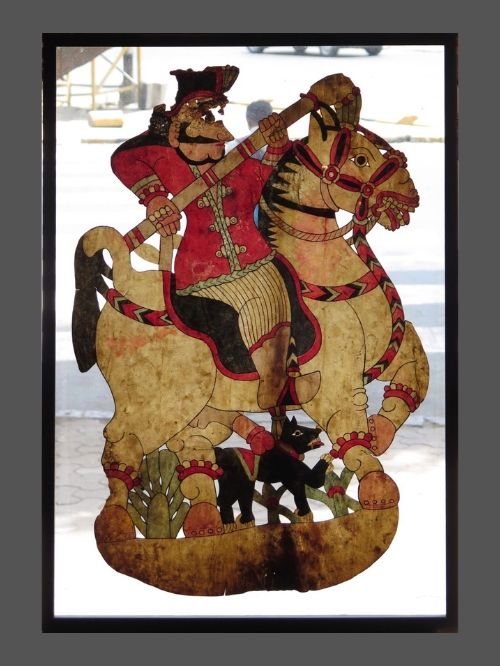
Karnataka (South India)
Framed Leather Shadow Puppet
The art of puppetry, called Togalugombayeta in Karnataka, involves acting out well known epic episodes using puppets made of flat leather pieces operated by a stick. The perforated leather is illuminated from behind, making this a form of shadow theatre. It is thought that the puppets were invented to avoid having gods and goddesses – who feature prominently in Indian epics like the Ramayana and Mahabharata – depicted by humans.
Size(cms): 91 (H) x 62 (L)
Size(inches): 35.8 (H) x 13.4 (L)
-
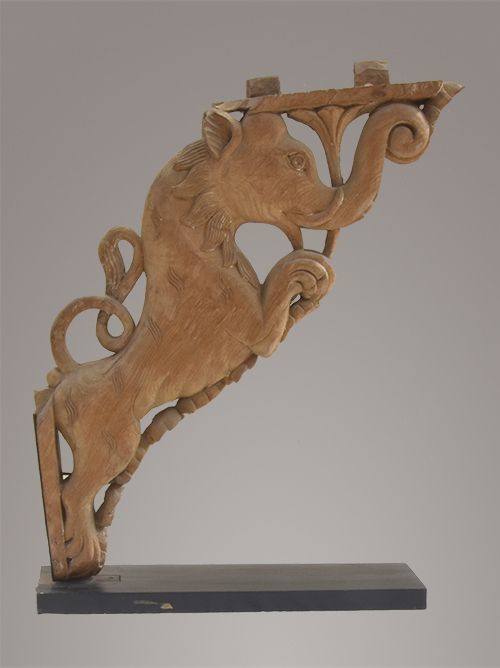
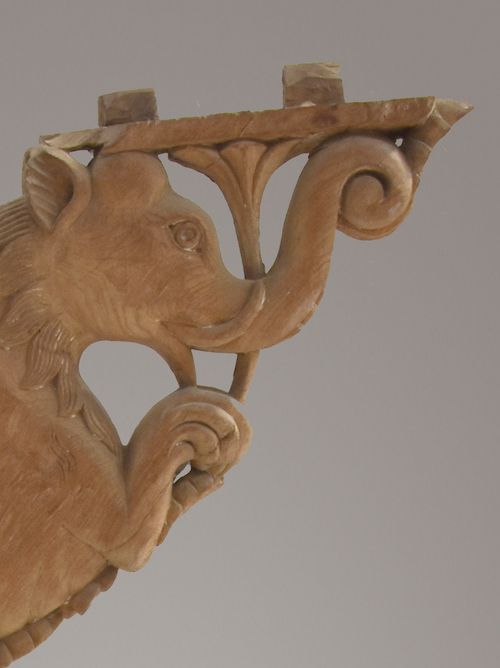
TEAK
c. 1920
The Makara is a mythical aquatic creature that combines the body of a crocodile with the head of a lion and the trunk of an elephant. One of India’s most ancient symbols, harking back more than two thousand years to a time when the natural world was seen as both symbol and reality, and fantastic creatures were invented to express the complexity of nature. The Makara is considered auspicious and purifying by Hindus and related to fertility. he is the vehicle (vahana) of Varuna, god of the waters of heaven and earth, and the emblem of Kama, the god of love.
Sizes (cms): 80 (H) x 62 (W) x 20 (D)
Sizes (inches): 31.4 (H) x 24.4 (W) x 7.9 (D)
-
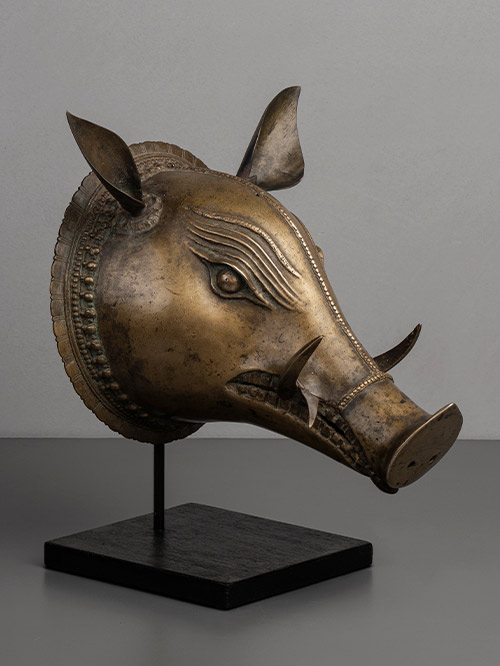
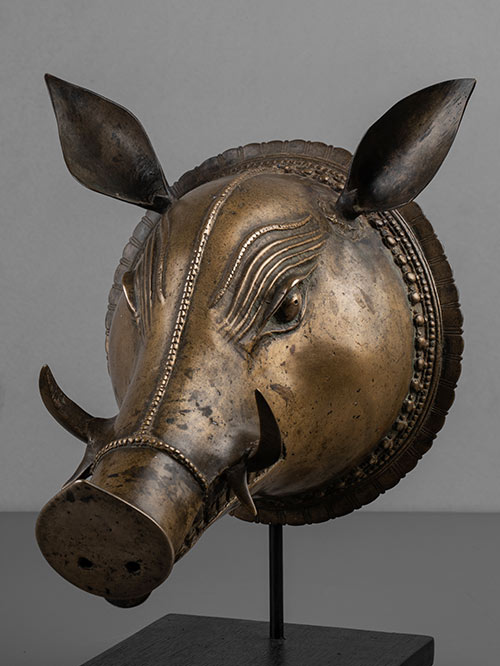
Coastal Karnataka (South India)
brass alloy
A finely detailed Panjurli (boar) mask with a symmetric conical shape, attractive colour, and rich patina. The head is adorned with a central vertical beaded rope that encircles the snout at one end and the head at its widest point. Features such as the eyes, ears, tusks, and snout are meticulously crafted.
This mask comes from the bhuta tradition on the Malabar coast. The bhuta and daiva, local divine or deified beings are highly prevalent in the southern parts of the Kannara district. Though now largely confined to south Kannara, certain areas of north Kannara and even Sri Lanka, bhuta cults once existed all over India under different names and forms. These cults, which are of considerable antiquity, have much in common with those of the yakshas, for instance. Like bhutas, yakshas are a ‘queer blend of what is sublime and mundane, profound and profane.’⠀
In Tulu Nadu, hordes of boars often invaded and destroyed the cultivated lands so the farmers started worshipping and giving offerings to Panjurli, the spirit in the form of a boar, thinking that this would appease his mood and thus keep the wild animals away from their fields.
Mask Size (cms): 27(H) x 26(W) x 33(D), 35(H with stand)
Mask Size (inches): 10.5(H) x 10(W) x 13(D), 14(H with stand)
-
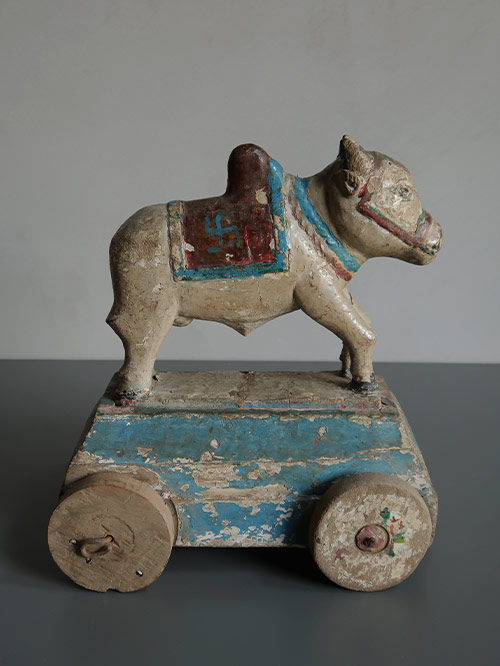
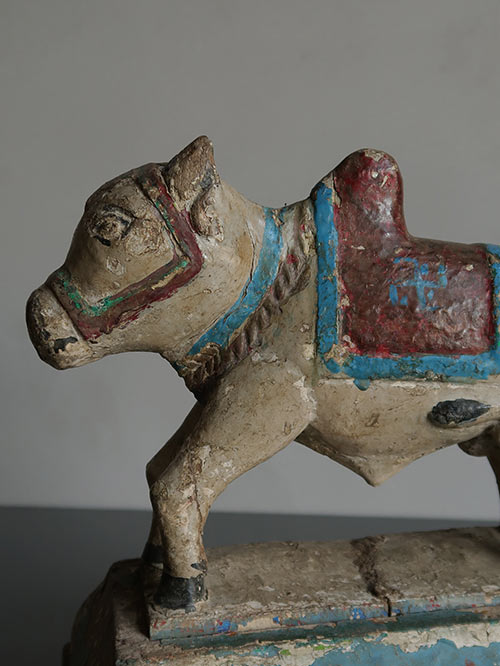
Maharashtra/Karnataka
Wood, polychromed
A decorative Nandi painted with patterns symbolising typical trappings including a saddle and head and neck ornaments. A right-facing swastik is painted on the saddle, symbolizing the sun, prosperity and good luck. The Nandi stands on a pedestal with wheels. Animal festival toys are used for ritual display and celebration during important festivities such as Pola, Holi, Shivaratri and Durga Puja.
Nandi festival toys have a special importance during the festival of Pola. Pola is an ancient thanks giving festival celebrated during the Hindu month of Sharavan during which farmers celebrate their cattle.
Nandi or Nandin means rejoicing, gladdening. It is the name of Shiva’s conveyance (vahana) the white bull, son of Kashyapa and of Surabhi. Nandi was probably a folk deity later incorporated into the Brahmanic lore. Nandi symbolises on the one hand moral and religious duty (dharma), and on the other, virility, fertility and strength. Apart from being Shiva’s vehicle, nandi in his form as nandikeshvara, depicted as a human with a bulls head, is believed to be one of the great masters of music and dancing. In southern India his recumbent image is placed either opposite the main sanctuary or in the hall leading to it, facing the linga.
Size (cms): 33.5(H) x 30(W) x 20(D)
Size (inches): 13(H) x 12(W) x 8(D)
-
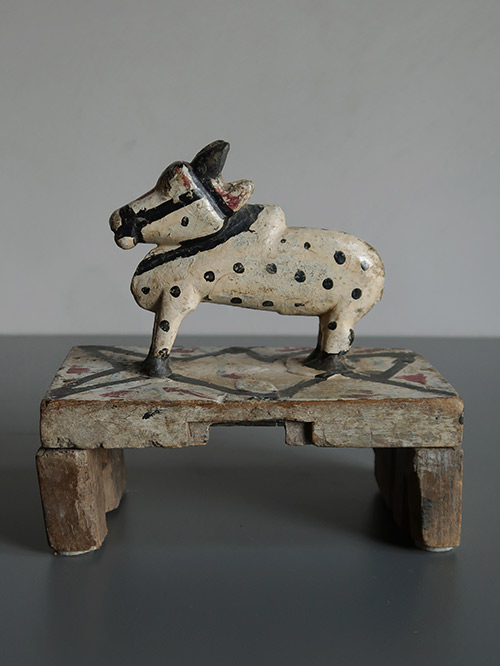
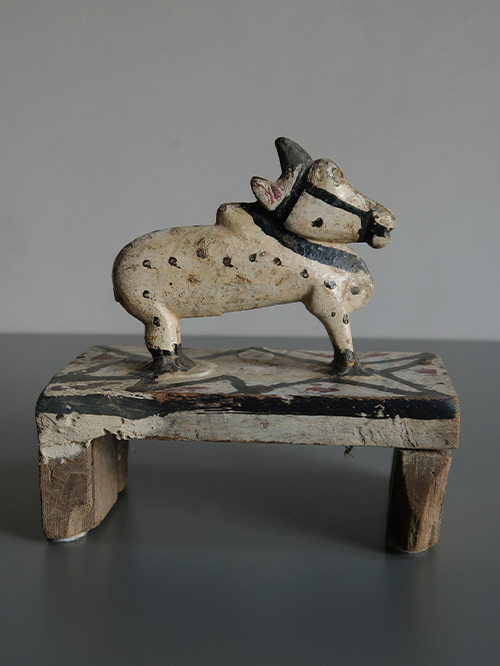
Maharashtra/Karnataka
Wood, polychromed
A decorative Nandi painted in white with black dots and typical trappings including a bridle bit. The Nandi stands on a pedestal painted with a geometric star. Animal festival toys are used for ritual display and celebration during important festivities such as Pola, Holi, Shivaratri and Durga Puja.
Nandi festival toys have a special importance during the festival of Pola. Pola is an ancient thanks giving festival celebrated during the Hindu month of Sharavan during which farmers celebrate their cattle.
Nandi or Nandin means rejoicing, gladdening. It is the name of Shiva’s conveyance (vahana) the white bull, son of Kashyapa and of Surabhi. Nandi was probably a folk deity later incorporated into the Brahmanic lore. Nandi symbolises on the one hand moral and religious duty (dharma), and on the other, virility, fertility and strength. Apart from being Shiva’s vehicle, nandi in his form as nandikeshvara, depicted as a human with a bulls head, is believed to be one of the great masters of music and dancing. In southern India his recumbent image is placed either opposite the main sanctuary or in the hall leading to it, facing the linga.
Size (cms): 21(H) x 20(W) x 12(D)
Size (inches): 8.5(H) x 8(W) x 4.5(D)
-

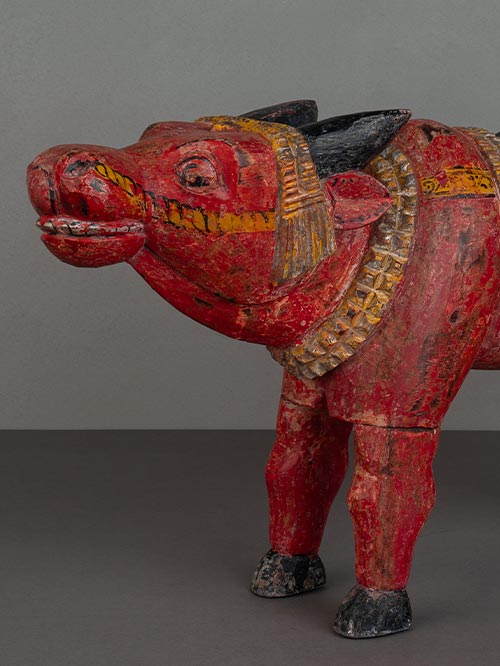
Coastal Karnataka (Bhuta culture)
Wood, polychromed
A fine painted wood figure of a standing nandi. Displaying the typical folk bhuta style of coastal Karnataka, this figure is painted predominantly in red with a painted saddlecloth and a curled back tail resting on its back.
The bhuta tradition is popular on the Malabar coast. Bounded by the dramatic sweep of the forested ghats to the east and the Arabian sea to the west, and encircled by rivers, the South Kanara district of coastal Karnataka has enjoyed relative geographic isolation until recent years. The totemic origin of this bull bhuta is quite obvious in a land of agriculture and farms where ploughs are pulled by bulls and where cow milk is one of the main sources of protein. The link with Hinduism is also easily established through Nandi the vahana (“vehicle”) of god Shiva.
Size (cms): 32(H) x 52(W) x 14(D)
Size (inches): 12.5(H) x 20.5(W) x 5.5(D)
-
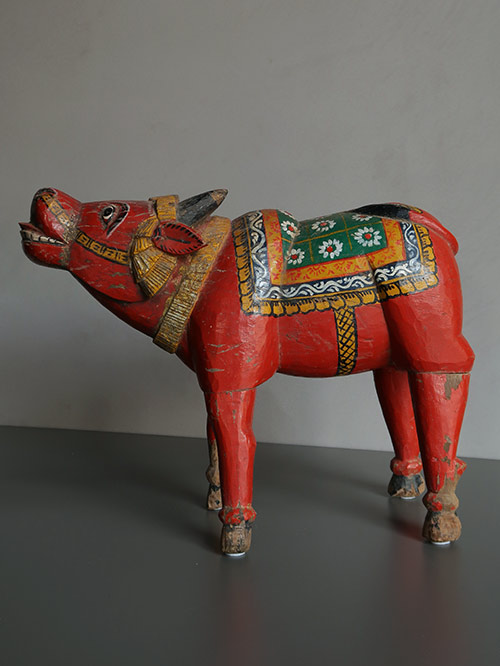
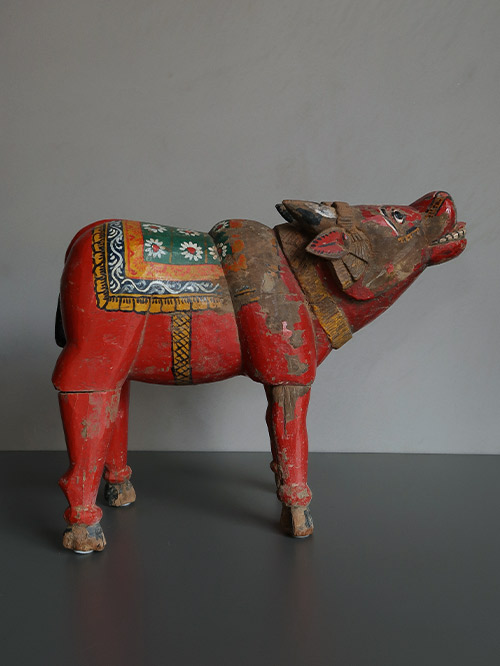
Coastal Karnataka (Bhuta culture)
Wood, polychromed
A large painted wood figure of a standing nandi. Displaying the typical folk bhuta style of coastal Karnataka, this figure is painted predominantly in red with a floral painted saddlecloth and a curled back tail resting on its back.
The bhuta tradition is popular on the Malabar coast. Bounded by the dramatic sweep of the forested ghats to the east and the Arabian sea to the west, and encircled by rivers, the South Kanara district of coastal Karnataka has enjoyed relative geographic isolation until recent years. The totemic origin of this bull bhuta is quite obvious in a land of agriculture and farms where ploughs are pulled by bulls and where cow milk is one of the main sources of protein. The link with Hinduism is also easily established through Nandi the vahana (“vehicle”) of god Shiva.
Size (cms): 36(H) x 46(W) x 16(D)
Size (inches): 14(H) x 18(W) x 6.5(D)
-
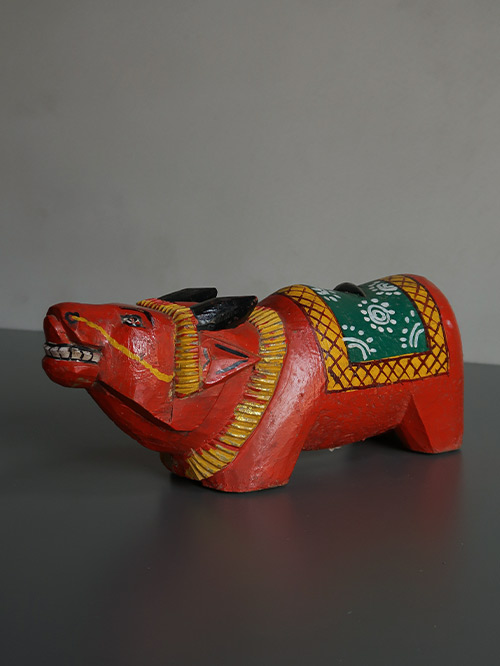
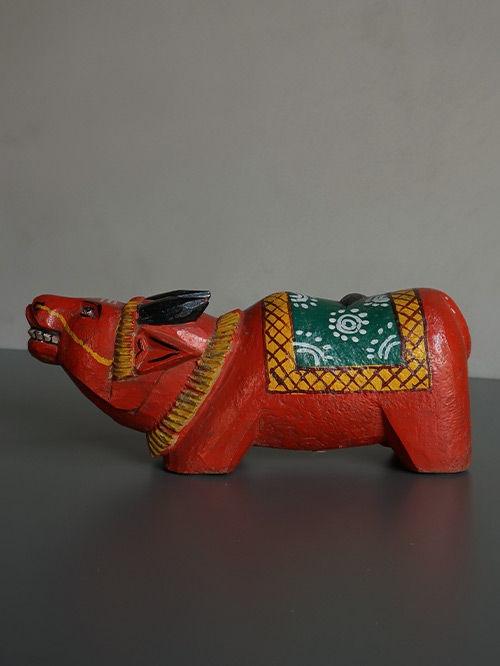
Coastal Karnataka (Bhuta culture)
Wood, polychromed
A fine painted wood figure of a standing nandi. Displaying the typical folk bhuta style of coastal Karnataka, this figure is painted predominantly in red It displays a typical stylised form with a horizontal head with slightly protruding tongue, horns adorned with ornaments, a floral painted saddlecloth and a curled back tail resting on its back.
The bhuta tradition is popular on the Malabar coast. Bounded by the dramatic sweep of the forested ghats to the east and the Arabian sea to the west, and encircled by rivers, the South Kanara district of coastal Karnataka has enjoyed relative geographic isolation until recent years. The totemic origin of this bull bhuta is quite obvious in a land of agriculture and farms where ploughs are pulled by bulls and where cow milk is one of the main sources of protein. The link with Hinduism is also easily established through Nandi the vahana (“vehicle”) of god Shiva.
Size (cms): 14(H) x 35.5(W) x 11(D)
Size (inches): 5.5(H) x 14(W) x 4.5(D)
-
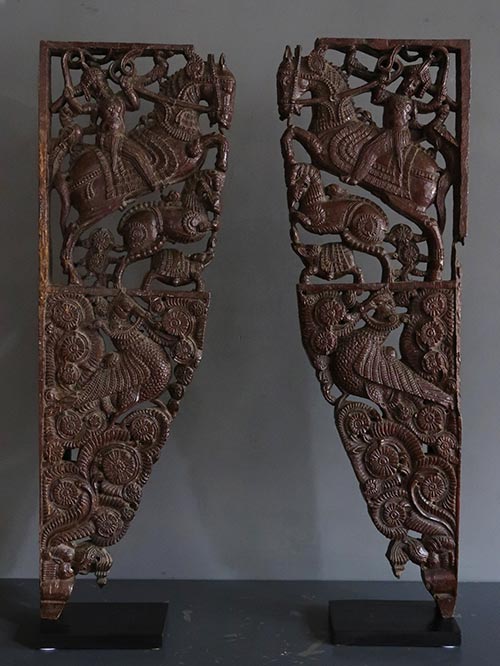
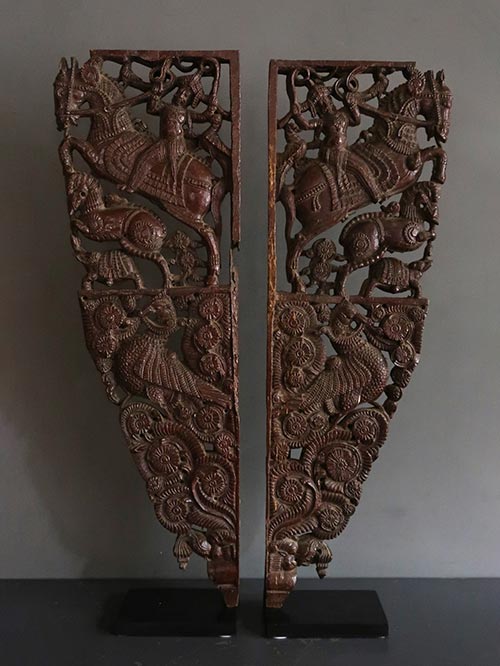
Tamil Nadu
Wood
A pair of extremely fine and large carved and pierced doorway brackets, from the entrance door of a Chettinad mansion. They depict a dense arrangement comprising elaborately caparisoned rearing horses with turbaned and ornamented riders holding whips in the upper register. The pointed turbans worn by these riders is an indication of their royal status. The raised forelegs of the horses rest on the heads of rearing Vyalis – open mouthed and with bulging eyes, who in turn are supported by the trunks of diminutive elephants. At the lower end are parrots perched vertically. The remarkable density of the composition is achieved by filling almost every available space with swirling foliage.
Size individual (cms): 96 (H) x 31 (W) x 15 (D)
Size individual (inches): 37.8 (H) x 12.2 (W) x 6 (D)
-
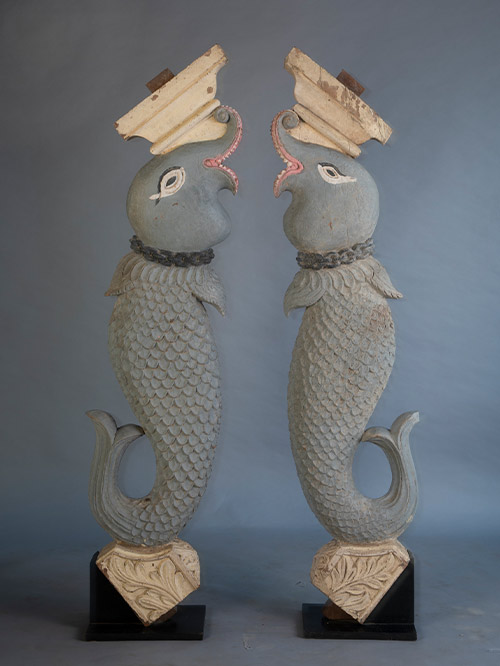
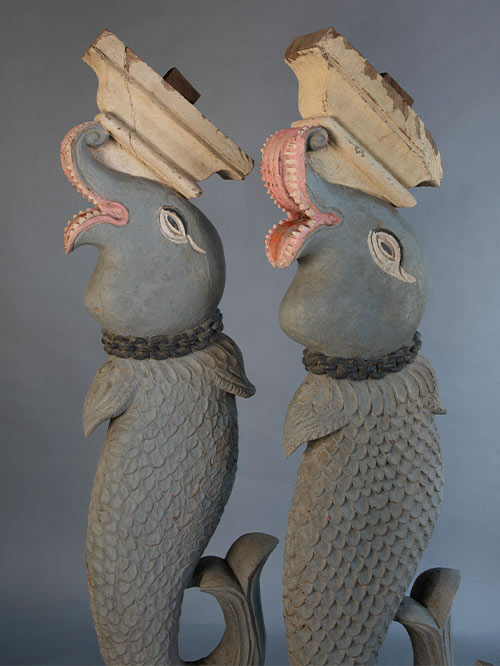
Gujarat (Western India)
Wood with polychrome
An unusual and impressive set of carved makara brackets (architectural struts) probably originally from the upper pavilion of a mansion or temple. Their open mouths reveal rows of prominent teeth, the upper jaw is formed as a short upturned trunk. The necks have a linked chain, the lower body is encompassed by scales resembling a fish and have an upturned tail.
The Makara is a mythical aquatic creature that is said to combine the body of a crocodile with the head of a lion and the trunk of an elephant. One of India’s most ancient symbols, harking back more than two thousand years to a time when the natural world was seen as both symbol and reality, and fantastic creatures were invented to express the complexity of nature. The Makara is considered auspicious and purifying by Hindus and related to fertility. He is the vehicle (vahana) of Varuna, god of the waters of heaven and earth, and the emblem of Kama, the god of love.
Individual Sizes (cms): 155(H) x 38(W) x 21(D)
Individual Sizes (inches): 61(H) x 15(W) x 8.5(D)
-
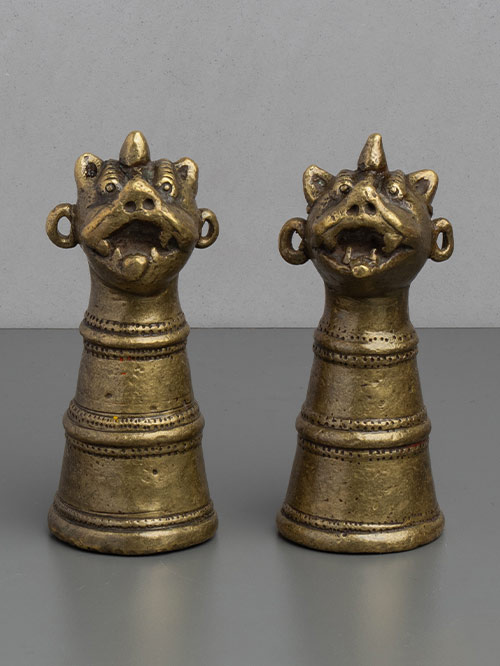

Karnataka
Brass
A decorative pair of horn cap ornaments with vyali (lion) finials. They would have been fixed to nandi (bull) horn ends as a decorations for the Pola festival, during which draft animals are thanked for their help in plowing the fields.
Nandi or nandin, the bull vahana of Shiva has always been noted for his strength and virility. Usually depicted in a life-like naturalistic manner, Nandi is present in every Shaivite temple, often with his own temple enclosure but facing the Shiva lingam. Figures like this of Nandi on a platform base with a cobra canopy are common objects of worship, especially found in home shrines.
Indiv. Sizes (cms): 12(H) x 5(W) x 5(D) each
Indiv. Sizes (inches): 4.5(H) x 2(W) x 2(D) each
-


Karnataka (South India)
brass alloy
This gracefully proportioned standing Nandi is delicately incised with head and neck ornaments and stands on a trapezoidal base.
Nandi or nandin, the bull vahana of Shiva has always been noted for his strength and virility. Usually depicted in a life-like naturalistic manner, Nandi is present in every Shaivite temple, often with his own temple enclosure but facing the Shiva lingam. Figures like this of Nandi on a platform base with a cobra canopy are common objects of worship, especially found in home shrines.
Size (cms): 16.5(H) x 10.8(W) x 7.6(D)
Size (inches): 6.5(H) x 4.5(W) x 3(D)

































